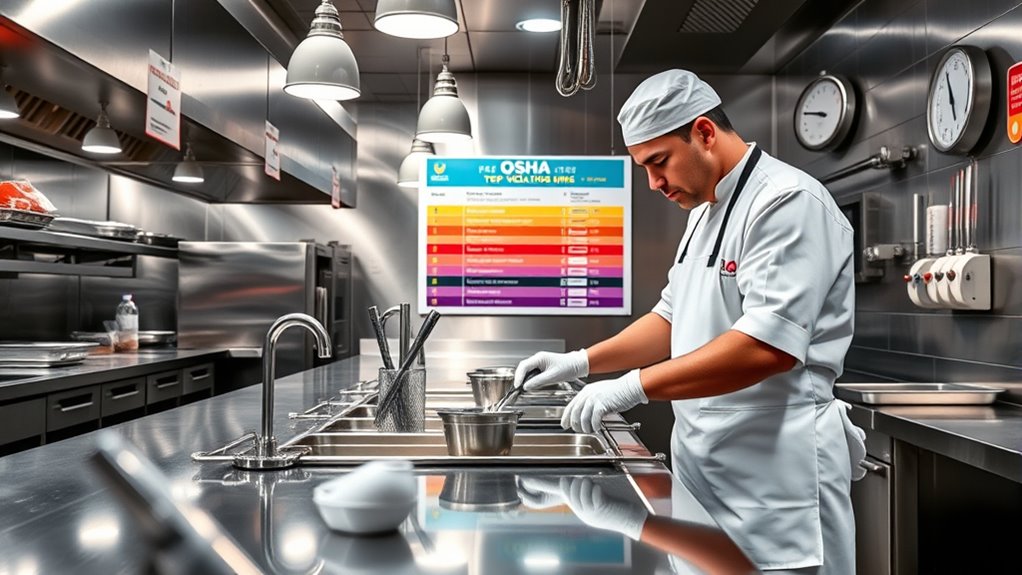To avoid OSHA’s top restaurant violations, focus on keeping walkways clear and dry, store food and chemicals properly, and train staff on equipment safety and proper PPE use. Maintain good ventilation, keep fire safety equipment accessible, and follow safe lifting techniques. Regularly inspect electrical systems and document safety practices. Staying proactive in these areas reduces violations—continue to learn how to create a safer, compliant environment for your team.
Key Takeaways
- Regularly inspect and maintain walkways, flooring, and lighting to prevent slip, trip, and fall hazards.
- Properly store chemicals separately from food and label all containers to avoid contamination violations.
- Train staff thoroughly on equipment use, PPE, and safety protocols to reduce accidents and violations.
- Conduct routine fire and electrical safety checks, including extinguisher readiness and equipment grounding.
- Keep accurate records of training, inspections, and incidents to demonstrate compliance and identify hazards early.
Slips, Trips, and Falls Prevention

To prevent slips, trips, and falls in your restaurant, it’s essential to identify and address common hazards proactively. Wet floors from spills, leaks, or cleaning can quickly cause accidents if not managed properly. Always use wet floor signs and clean spills immediately. Uneven flooring, loose mats, or cluttered walkways also pose risks. Regularly inspect high-traffic areas for hazards and keep all pathways clear. Proper footwear with slip-resistant soles is vital for staff. Train employees to promptly report hazards and ensure they understand safety procedures. Good lighting helps staff see potential dangers clearly. Maintaining a safe environment by following these precautions helps minimize accidents. By staying vigilant and maintaining a clean, organized environment, you can greatly reduce slip, trip, and fall incidents, protecting both your staff and customers.
Proper Storage and Handling of Food and Chemicals

You need to guarantee chemicals are stored safely away from food to prevent contamination. Proper temperature control of food keeps it fresh and safe to eat. Failing to follow these practices can lead to violations and health risks. Incorporating water safety protocols can further reduce the risk of contamination and promote a healthier environment.
Safe Chemical Storage Practices
Proper storage and handling of food and chemicals are essential for maintaining a safe restaurant environment. You should always store chemicals separately from food to prevent cross-contamination. Use clearly labeled, leak-proof containers and keep chemicals in designated areas away from food prep zones. Ensure chemicals are stored at appropriate temperatures and conditions, following manufacturer instructions. Regularly inspect storage areas for leaks, spills, or expired products, and clean them promptly. Keep chemicals secured to prevent accidental spills or misuse, especially around staff and customers. Train your team on proper handling procedures and emphasize the importance of safety protocols. Proper storage practices also include understanding chemical safety guidelines to minimize hazards. By maintaining organized, secure storage practices, you reduce risks and guarantee compliance with OSHA regulations, safeguarding both your staff and your patrons.
Proper Food Temperature Control
Maintaining the correct food temperatures is crucial to prevent bacterial growth and guarantee food safety. You need to keep cold foods at 40°F or below and hot foods at 140°F or above. Use a reliable thermometer to check temperatures regularly, especially during storage, cooking, and holding. Properly label and date perishable items so you know when to use or discard them. Store raw meats separately from ready-to-eat foods to prevent cross-contamination. Avoid leaving food out at room temperature for more than two hours, or one hour if it’s hot outside. When handling chemicals or cleaning supplies, make sure they’re stored away from food to prevent accidental contamination. Consistent temperature control minimizes foodborne illness risks and helps you stay compliant with safety regulations. Proper storage practices are essential for maintaining food quality and safety standards.
Employee Training on Safe Equipment Use
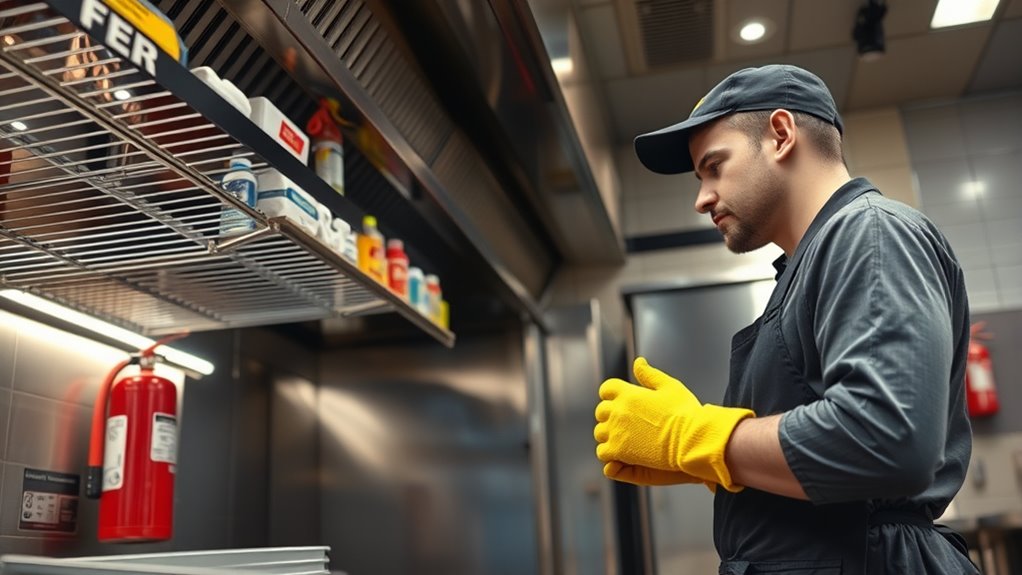
Ensuring employees are properly trained on safe equipment use is essential for preventing accidents and maintaining a compliant restaurant environment. You need to provide thorough training on how to operate all equipment correctly, including knives, slicers, fryers, and ovens. Demonstrate proper handling, cleaning, and maintenance procedures to reduce the risk of injuries and equipment malfunctions. Regularly review safety protocols and reinforce best practices through ongoing training sessions. Make sure employees understand the importance of using personal protective equipment (PPE) like gloves, aprons, and eye protection. Keep training records to show compliance and identify areas for improvement. Well-trained staff can prevent costly accidents, improve efficiency, and ensure your restaurant meets OSHA standards. Proper training creates a safer, more productive work environment for everyone. Incorporating proper safety procedures into training ensures consistent adherence to safety standards and helps minimize hazards.
Adequate Ventilation and Fire Safety Measures

You need proper ventilation systems to keep air clean and prevent the buildup of smoke and fumes. Implementing fire prevention strategies is essential to reduce the risk of fires in your restaurant. Ensuring these safety measures are in place helps protect both your staff and customers. Regular maintenance of ventilation and fire safety equipment is crucial to their effectiveness. Signs of spoilage in stored materials can also pose health risks if not properly monitored.
Proper Ventilation Systems
Proper ventilation systems are vital for maintaining a safe and healthy restaurant environment, especially when it comes to controlling smoke, fumes, and heat. A well-designed system removes airborne contaminants, reduces fire hazards, and guarantees compliance with OSHA standards. To optimize performance, you should regularly inspect and clean exhaust hoods, filters, and ducts. Proper placement and capacity are essential for effective airflow. Here’s a quick guide to key ventilation components:
| Component | Function | Maintenance Tips |
|---|---|---|
| Exhaust Hoods | Capture smoke and grease | Clean weekly to prevent buildup |
| Filters | Trap grease and particles | Replace as needed |
| Ducts | Ventilate air outside | Schedule professional cleaning |
Fire Prevention Strategies
Effective fire prevention in restaurants relies heavily on adequate ventilation and robust fire safety measures. Proper ventilation helps remove smoke, heat, and flammable vapors, reducing fire risk. To strengthen your fire safety, focus on these key steps:
- Regularly inspect and maintain exhaust hoods and ducts to prevent grease buildup.
- Install and keep fire extinguishers accessible, ensuring staff know how to use them.
- Keep emergency exits clear and well-marked for quick evacuation if needed.
- Incorporate fire safety training for staff to ensure proper response in case of emergencies.
Correct Use of Personal Protective Equipment (PPE)

Ensuring the correct use of Personal Protective Equipment (PPE) is essential for maintaining safety in restaurant environments. Proper PPE use prevents injuries and exposure to hazards. Always select the right gear for the task, whether gloves, aprons, or eye protection. Make sure PPE fits properly—loose or tight gear can compromise safety. Train staff on when and how to wear PPE correctly, and enforce consistent use. Regularly inspect PPE for damage and replace it when necessary. To help you stay organized, here’s a quick reference:
| PPE Type | When to Use | Proper Maintenance |
|---|---|---|
| Gloves | Handling chemicals or hot items | Wash or replace regularly |
| Eye Protection | Cutting onions or cleaning spills | Clean after use |
| Aprons | Food prep, cleaning surfaces | Launder frequently |
Using PPE correctly reduces risks and keeps everyone safe. Proper training and awareness can also help prevent accidents or injuries related to PPE misuse.
Managing Hazardous Energy (Lockout/Tagout Procedures)

When handling equipment that could pose energy hazards, implementing lockout/tagout procedures is essential for safety. These procedures prevent accidental energization during maintenance or repair, reducing injury risks. To effectively manage hazardous energy, you should:
- Identify all energy sources linked to the equipment.
- Shut down and isolate the equipment using proper lockout devices.
- Tag out the equipment to warn others it’s under maintenance.
- Incorporate sound vibrations to assess equipment status and detect anomalies before work begins.
Always verify that the energy has been fully released before starting work. Train your staff on these steps and enforce strict compliance. Proper lockout/tagout procedures protect everyone in your restaurant from potential injuries caused by unexpected equipment startup. Staying diligent with these safety measures minimizes violations and creates a safer work environment.
Maintaining Clean and Sanitary Workspaces
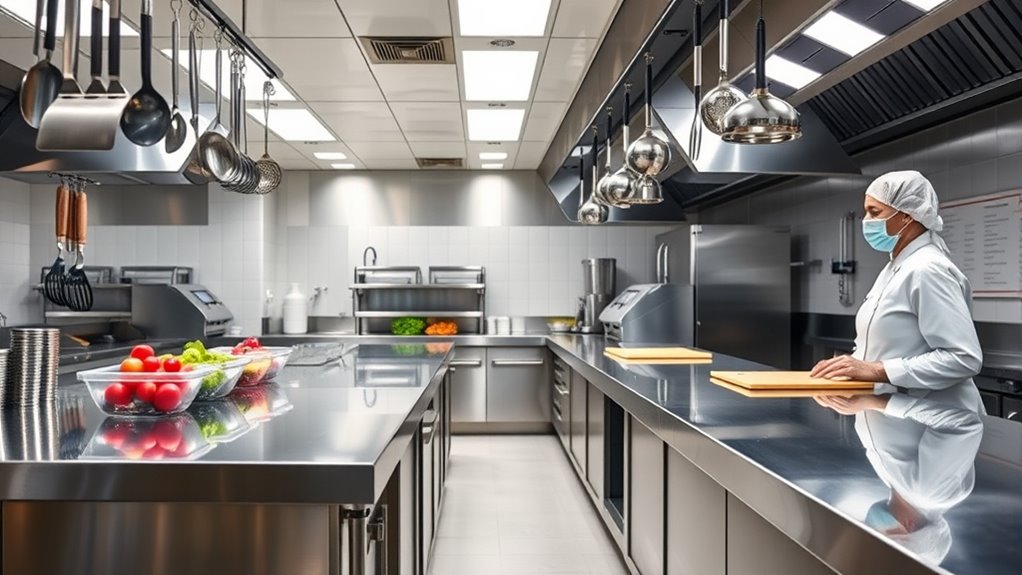
Have you ever considered how a clean and sanitary workspace impacts your restaurant’s safety and customer satisfaction? Keeping your kitchen surfaces, utensils, and equipment sanitized reduces the risk of foodborne illnesses and cross-contamination. Regular cleaning prevents mold, bacteria buildup, and pests, which can threaten health and violate OSHA standards. Make certain your staff follows proper handwashing protocols and uses appropriate cleaning supplies. Implement a routine schedule for deep cleaning and sanitation, and train your team on proper procedures. Proper waste disposal and maintaining dry, clutter-free work areas also play vital roles in safety. Paying attention to cleaning protocols and ensuring consistent adherence helps maintain compliance and protect your establishment. When you prioritize cleanliness, you create a safer environment for staff and a more enjoyable experience for customers—ultimately protecting your reputation and avoiding costly violations.
Electrical Safety and Prevention of Shock Hazards
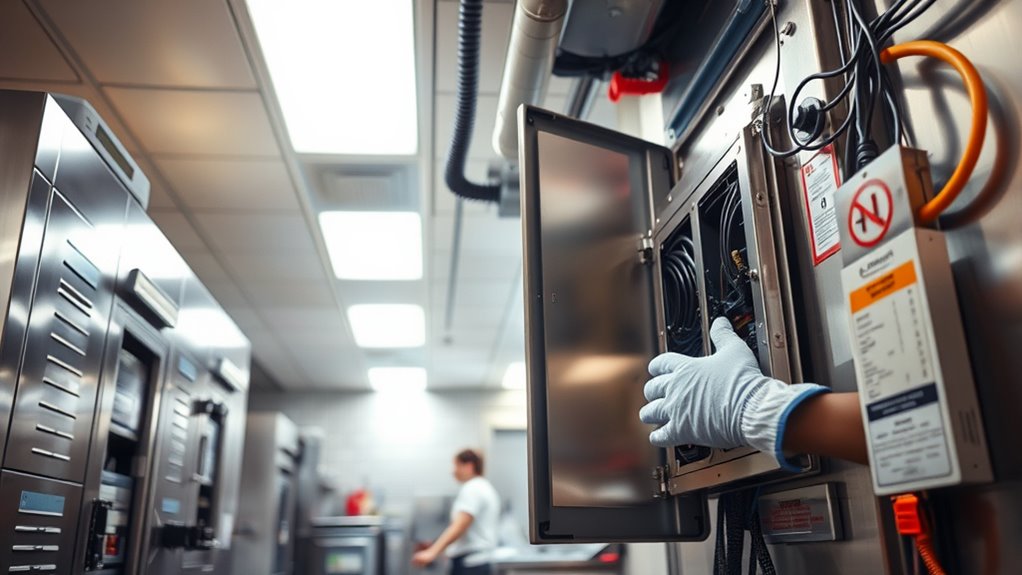
Are you aware of the common electrical hazards in your restaurant that could lead to shock injuries? Electrical issues often go unnoticed but can be dangerous. To prevent shocks, focus on:
- Regularly inspecting cords and outlets for damage or wear.
- Ensuring all electrical equipment is properly grounded and connected.
- Avoiding overloading circuits, which can cause overheating and short circuits.
Make sure outlets are covered, and use GFCI (Ground Fault Circuit Interrupters) in wet areas like kitchens and restrooms. Keep cords away from water, heat, or sharp objects. Train staff to recognize electrical hazards and report issues promptly. Taking these steps reduces the risk of shock injuries and keeps your restaurant safe.
Safe Lifting and Ergonomics Practices
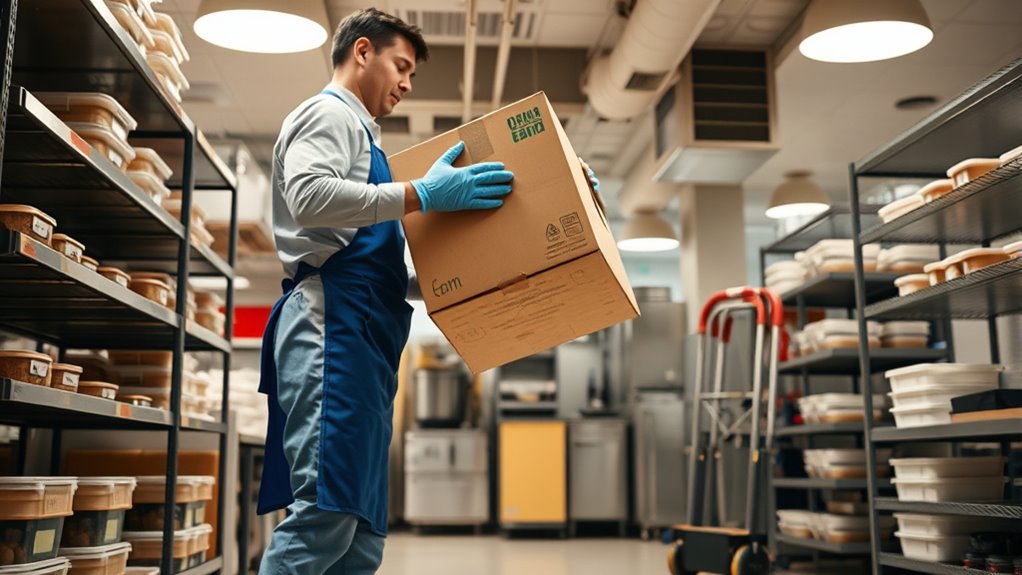
You can prevent injuries by using proper lifting techniques and setting up your workspace ergonomically. Always lift with your legs, not your back, and keep the load close to your body. Adjust your workstation to reduce strain and improve comfort throughout your shift.
Proper Lifting Techniques
Proper lifting techniques are essential to prevent injuries and promote a safe working environment in restaurants. To do this effectively, focus on these key steps:
- Plan your lift: Ensure a clear path and assess the weight before lifting.
- Use your legs: Bend at your hips and knees, not your back, and lift with your leg muscles.
- Keep the load close: Hold objects close to your body to reduce strain and maintain balance.
Always avoid twisting your torso while lifting, and ask for help with heavy or awkward items. Proper technique not only protects your back but also keeps you efficient during busy shifts. Consistently applying these practices helps prevent common injuries and keeps your work environment safe.
Ergonomic Workspace Setup
Creating an ergonomic workspace setup is essential for reducing strain and preventing injuries during lifting and other tasks in restaurants. Start by adjusting your work surfaces to waist height so you don’t have to bend or stretch excessively. Use mats or anti-fatigue flooring to lessen fatigue during long periods standing. Arrange frequently used tools and supplies within easy reach to avoid overextending your arms or twisting your body. Ensure your posture stays upright, with shoulders relaxed and feet flat on the ground. If possible, use mechanical aids like dollies or carts for heavy items. Regularly assess your workspace to identify and correct ergonomic hazards. Implementing these practices helps minimize fatigue, prevents musculoskeletal disorders, and keeps you safe on the job.
Recordkeeping and Documentation Compliance

Accurate recordkeeping and thorough documentation are essential components of compliance with OSHA regulations in the restaurant industry. Proper records not only demonstrate your commitment to safety but also help you identify hazards and improve protocols. To stay compliant, focus on these key areas:
Accurate records and thorough documentation are vital for OSHA compliance and safety improvements.
- Keep detailed injury and illness logs, updating them promptly after incidents.
- Maintain training records, including dates and topics covered for each employee.
- Store inspection reports and safety audits securely for at least five years.
Neglecting documentation can lead to penalties and diminished safety accountability. Make sure your records are complete, organized, and accessible. Regularly review your documentation practices to ensure they meet OSHA standards. Staying diligent now saves you time and trouble later.
Frequently Asked Questions
How Often Should Safety Training Sessions Be Conducted for Restaurant Staff?
You should conduct safety training sessions for your restaurant staff at least annually to make certain everyone stays informed about safety protocols. Additionally, hold refresher courses whenever new equipment, procedures, or regulations are introduced. Regular training helps prevent accidents and keeps safety top of mind. Incorporate brief weekly safety reminders or quick meetings to reinforce proper practices. Consistent training demonstrates your commitment to a safe work environment and helps avoid violations.
What Are the Most Common Violations Related to Chemical Storage in Restaurants?
Chemical storage concerns can cause chaos if not carefully controlled. You should regularly review and restrict chemical storage areas, ensuring chemicals are properly labeled, sealed, and stored away from heat and food prep zones. Avoid accidental spills or exposures by implementing strict safety standards and maintaining organized, accessible storage solutions. Proper procedures protect your staff and prevent violations, keeping your restaurant compliant, clean, and safe.
How Can Restaurants Ensure Compliance With Osha’S Recordkeeping Requirements?
To guarantee compliance with OSHA’s recordkeeping requirements, you should keep detailed, accurate records of all work-related injuries and illnesses. Regularly update your logs and reports, and train your staff on proper documentation procedures. Use OSHA’s forms properly and maintain them for at least five years. Staying organized and proactive helps you avoid penalties and demonstrates your commitment to workplace safety. Regular audits can also ensure ongoing compliance.
What Are Best Practices for Maintaining Fire Safety Equipment in a Restaurant?
Think of your fire safety equipment as the heartbeat of your restaurant’s safety. You guarantee it’s inspected regularly, just like a doctor checks vital signs. Keep fire extinguishers and alarms visible, accessible, and in working order. Train your staff on proper usage, and replace outdated gear promptly. By maintaining this safety system, you protect lives and keep your restaurant running smoothly—because prevention is your first line of defense.
How Can Managers Effectively Monitor PPE Compliance Among Employees?
To effectively monitor PPE compliance, you should regularly conduct spot checks and observe employee practices. Encourage open communication so staff feel comfortable reporting issues or concerns. Implement clear policies and provide ongoing training to emphasize the importance of PPE. Use visual cues like signage, and maintain a checklist to track PPE usage. Consistent supervision and positive reinforcement help guarantee everyone adheres to safety standards consistently.
Conclusion
By staying vigilant and following these safety tips, you’re steering clear of OSHA’s pitfalls, much like maneuvering a treacherous kitchen without a map. Remember, safety isn’t just about avoiding violations—it’s about protecting your team and your reputation. Keep your workspace as tight as a well-oiled machine, and you’ll guarantee everyone returns home safe, just like heroes emerging victorious from a challenging quest. Stay proactive, and let safety be your guiding star.
